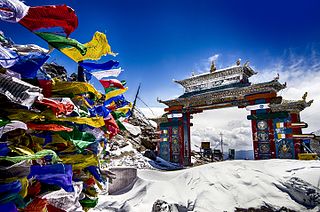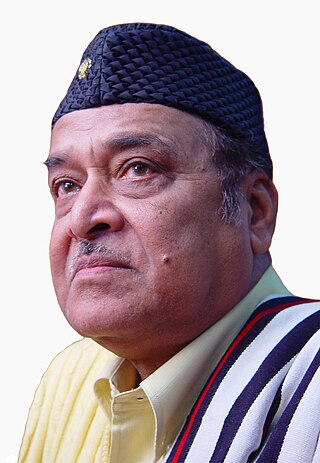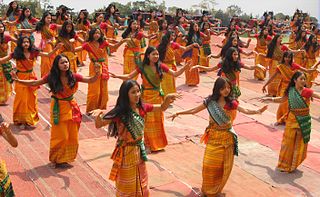
Assam is a state in northeastern India, south of the eastern Himalayas along the Brahmaputra and Barak River valleys. Assam covers an area of 78,438 km2 (30,285 sq mi). The state is bordered by Bhutan and Arunachal Pradesh to the north; Nagaland and Manipur to the east; Meghalaya, Tripura, Mizoram and Bangladesh to the south; and West Bengal to the west via the Siliguri Corridor, a 22-kilometre-wide (14 mi) strip of land that connects the state to the rest of India. Assamese and Boro are the official languages of Assam, while Bengali is an official language in the three districts of Barak Valley.

Northeast India (officially the North Eastern Region(NER)) is the easternmost region of India representing both a geographic and political administrative division of the country. It comprises eight states—Arunachal Pradesh, Assam, Manipur, Meghalaya, Mizoram, Nagaland and Tripura (commonly known as the "Seven Sisters"), and the "brother" state Sikkim.

The Bihu dance is an indigenous folk dance from the Indian state of Assam related to the Bihu festival and an important part of Assamese culture. Performed in a group, the Bihu dancers are usually young men and women, and the dancing style is characterized by brisk steps, and rapid hand movements. The traditional costume of dancers is colorful and centered round the red color theme, signifying joy and vigour. It is a festival of joy and happiness.
Sattriya, or Sattriya Nritya, is a major Indian classical dance. This dance was initially created as part of Bhaona which are performances of Ankiya Nat, one-act plays, originally created by Sankardev, the 15th-16th century polymath from Assam. These dances are part of the living traditions today of Sattras, which are communities of live-in devotees belonging to the Ekasarana dharma, the religion established by Sankardev.

Guwahati is the biggest city of the Indian state of Assam and also the largest metropolis in northeastern India. Dispur, the capital of Assam, is in the circuit city region located within Guwahati and is the seat of the Government of Assam. A major riverine port city along with hills, and one of the fastest growing cities in India, Guwahati is situated on the south bank of the Brahmaputra. The city is known as the "gateway to North East India".

The music of Assam consists various genres of folk and modern music, drawing its artistic basis from the history of Assam, from Assamese culture and its ancient traditions. In recent times, starting from the late eighties, popular artistes have modernized the music catering to local popular demand.

The Asam Sahitya Sabha is a non Government, non profit, literary organisation of Assam. It was founded in December 1917 in Assam, India to promote the culture of Assam and Assamese literature. A branch of the organisation named Singapore Sahitya Sabha was launched in Singapore on July 28, 2019.

Bhupen Hazarika was an Indian playback singer, lyricist, musician, poet, actor, artist, editor, filmmaker, professor and politician from Assam, widely known as Sudha Kontho. His songs were written and sung mainly in the Assamese language by himself, are marked by humanity and universal brotherhood and have been translated and sung in many languages, most notably in Bengali and Hindi.

Sangeet Natak Akademi Award, also known as the Akademi Puraskar, is an award given by the Sangeet Natak Akademi, India's National Academy of Music, Dance & Drama. It is the highest Indian recognition given to people in the field of performing arts.

Bhawaiya is a musical form or a popular folk music that originated in Northern Bengal, especially the Rangpur Division in Bangladesh, Cooch Behar district of West Bengal, India, and the Undivided Goalpara district of Assam, India. It has recurrent themes of the "working class", mahouts, mahishals, and gariyals. Lyrics express pangs of separation and loneliness of their womenfolk, with elongated tones accentuating pain, longing and "deep emotion". Bhawaiya is generally believed to have originated in the 16th century under Biswa Singha, and has evolved into stage performances since the 1950s. The lyrics of Bhawaiya songs are non-denominational. Bhawaiya is really popular during the Bengali occasion of Eid Al Fitr and Eid Al Adha.

Zubeen Garg is an Indian singer, songwriter, composer, lyricist, music director, music producer, actor, film director, film producer, screenwriter, poet and philanthropist. He primarily works for and sings in the Assamese, Bengali and Hindi-language film and music industries, but has sung in many other languages and dialects, including Bishnupriya Manipuri, Boro, English, Goalpariya, Kannada, Karbi, Khasi, Malayalam, Marathi, Mising, Nepali, Odia, Sanskrit, Sindhi, Tamil, Telugu, Tiwa. He is also a multi-instrumentalist and plays 12 instruments including anandalahari, dhol, dotara, drums, guitar, harmonica, harmonium, mandolin, keyboard, tabla and various percussion instruments. He is Assam's highest-paid singer.

The Bagurumba is a traditional dance of the indigenous Boro people living in the State of Assam and North East India. It is also called '''butterfly dance''' because it's personification of movements of butterflies and birds. In this occasion, only the Bodo women perform the dance, wearing their colourful traditional attire dokhna, jwmgra (fasra) and aronai. The dance is accompanied by handmade percussion instruments such as 'kham', sifung, jota, serja, and gongwna, tharkha.

Goalpariya is a group of Indo-Aryan dialects spoken in the Goalpara region of Assam, India. Along with Kamrupi, they form the western group of Assamese dialects. The North Bengali dialect is situated to its west, amidst a number of Tibeto-Burman speech communities. The basic characteristic of the Goalpariya is that it is a composite one into which words of different concerns and regions have been amalgamated. Deshi people speak this language and there are around 20 lakhs people.

Assamese cinema, is an Indian film industry of Assamese-language. It is based in Assam, India. The industry was born in 1935 when Jyoti Prasad Agarwala released his movie Joymoti. Since then the Assamese cinema has developed a slow-paced, sensitive style, especially with the movies of Bhabendra Nath Saikia and Jahnu Barua. In beginning the industry were called Jollywood, named for Agarwala's Jyoti Chitraban Film Studio.

The culture of Assam is traditionally a hybrid one, developed due to cultural assimilation of different ethno-cultural groups under various political-economic systems in different periods of its history.

The Assamese people are a socio-ethnic linguistic identity that has been described at various times as nationalistic or micro-nationalistic. This group is often associated with the Assamese language, the easternmost Indo-Aryan language, and Assamese people mostly live in the Brahmaputra Valley region of Assam, where they are native and constitute around 56% of the Valley's population. The use of the term precedes the name of the language or the people. It has also been used retrospectively to the people of Assam before the term "Assamese" came into use. They are an ethnically diverse group formed after centuries of assimilation of Austroasiatic, Tibeto-Burman, Indo-Aryan and Tai populations, and constitute a tribal-caste continuum—though not all Assamese people are Hindus and ethnic Assamese Muslims numbering around 42 lakh constitute a significant part of this identity The total population of Assamese speakers in Assam is nearly 15.09 million which makes up 48.38% of the population of state according to the Language census of 2011.
Goalpariya Lokogeet is a folk music of Goalpara, sung to traditional lyrics. It is sung by goalpariya language speaking people. It was primarily Pratima Barua Pandey, who raised the profile of this hitherto unknown genre of music nationally in India. This genre of music is being kept alive by the Koch Rajbongshi community in their music festivals. Currently, albums of Goalpariya songs are released commercially; and Goalpariya musical motifs and instruments are increasingly used in popular music in India. Some noted singers are Bina Das Borthakur, Mini Bhattacharya, Nazmul Hoque, Allauddin Sarkar, Hamida Sarkar, Abdul Jabber, Rahima Begum Kalita ,Ayaan Anisur Etc.

'Bayanacharya' Shri Ghanakanta Bora Muktiyar is one of the most eminent exponents and gurus of Sattriya dance, a major classical dance tradition of Assam, India. He is also a renowned instrumentalist, choreographer and author. He has won the prestigious Sangeet Natak Akademi Award in 2001.

Jim Ankan Deka is an Indian musician, documentary film maker, photographer and director of Bangalore based organisation and music school Eastern Fare Music Foundation. He is the first person from Assam to open a music institute and a production house in Bangalore, India. He won multiple awards for his song Aawaz - speak up against sexual violence based on the 2012 Delhi gang rape incident.

Professor Maheswar Neog was an Indian academic who specialised in the cultural history of the North East India especially Assam, besides being an Assamese-language scholar and poet. He was a top Indologist, and his work covers all disciplines of Indian studies, folk-lore, language, dance, history, music, religion, drama, fine arts, paintings, historiography and hagiography, lexicography and orthography, epigraphy and ethnography. His research includes multi-dimensional features of Vaishnava renaissance in Assam through Srimanta Sankardev, Madhabdev, Damodardev, Haridev, Bhattadev and other Vaishnava saints of Assam.
















